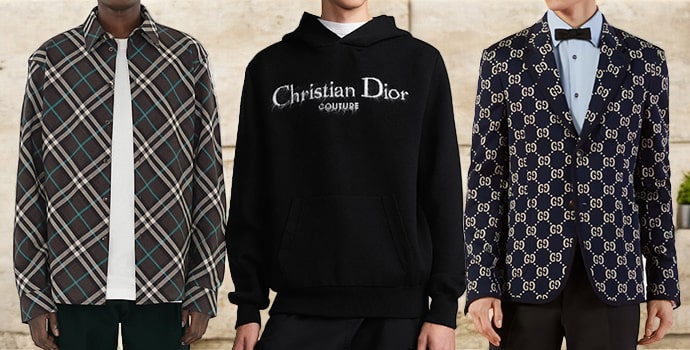Choosing Branded Clothing That Balances Durability and Elegance
Choosing Branded Clothing That Balances Durability and Elegance
Blog Article
Recognizing Apparel: The Importance of Fabric Options in Your Closet
The choice of textile in clothing plays an essential duty in both looks and performance. Various products provide varying degrees of convenience, breathability, and sturdiness, directly affecting the wearer's experience. Comprehending these subtleties can enhance one's closet considerably. Yet, lots of forget exactly how these options can impact not just personal style, but likewise sustainability. What fabric decisions could redefine your wardrobe and align it with both style and obligation?
The Function of Fabric in Fashion and Functionality

Common Material Types and Their Attributes
When picking garments, recognizing the attributes of common fabric kinds is essential for making educated options. Cotton, a widely-used natural fiber, is known for its convenience, breathability, and soft qualities, making it suitable for laid-back wear and daily garments. Linen, one more all-natural alternative, boasts exceptional moisture-wicking homes and a distinct structure, ideal for warm climates.Wool, usually favored for its warmth and sturdiness, differs in fineness; merino woollen is soft against the skin, while coarser types are made use of for outerwear. Synthetic materials like polyester and nylon provide sturdiness and resistance to wrinkles, making them popular for activewear and traveling garments. Blends, which incorporate natural and artificial fibers, can improve capability while maintaining convenience. By acknowledging these material characteristics, individuals can choose clothing that lines up with their way of life and aesthetic choices.
Breathability and Comfort: Choosing the Right Fabrics for Different Environments
Selecting the best materials for numerous environments can greatly enhance comfort and total wearability. Breathable materials are vital in warm climates, as they permit air blood circulation and wetness evaporation. Fabrics such as cotton, linen, and moisture-wicking synthetics effectively draw sweat far from the body, maintaining the wearer cool and dry. On the other hand, in colder climates, thicker textiles like woollen or fleece provide insulation while maintaining breathability, ensuring heat without overheating.Additionally, the choice of textile weight plays a vital function; light-weight fabrics are preferable for summer, whereas heavier options are fit for winter months wear. Recognizing the unique buildings of each material makes it possible for individuals to dress properly for differing climate condition. Eventually, choosing comfortable and breathable textiles customized to specific climates can significantly boost everyday convenience and enhance the total experience of using clothing.
Resilience and Treatment: How Fabric Impacts Long Life of Your Wardrobe
Selecting the best materials can greatly influence the longevity and treatment requirements of a closet. Fabrics such as cotton and polyester are recognized for their durability and simplicity of upkeep, making them perfect for daily wear. On the other hand, delicate products like silk and lace need even more careful handling and specialized cleaning methods, which can raise the moment and initiative needed for care. Branded Clothing.Durability is additionally influenced by the textile's weave and coating; firmly woven textiles have a tendency to resist wear and tear much better than freely woven alternatives. In addition, artificial blends frequently supply boosted resilience, incorporating the best top qualities of several fibers.Understanding the treatment guidelines for each and every fabric is important, as inappropriate washing or drying out have a peek here can bring about premature wear. Ultimately, choosing sturdy products can lead to a longer-lasting wardrobe, reducing the regularity of replacements and adding to an extra sustainable style option
The Influence of Textile on Fit and Silhouette

Lasting Fabric Options: Making Eco-Friendly Choices
The impact of textile extends beyond fit and silhouette to incorporate environmental elements, prompting a growing interest in lasting material options. Eco-friendly fabrics, such as natural cotton, hemp, and Tencel, are getting traction among consumers that prioritize sustainability in their wardrobes. These products are frequently produced with less chemicals and water, reducing their eco-friendly footprint.Additionally, recycled materials, made from post-consumer waste, use an ingenious service to the fabric sector's pollution problem. Brands significantly embrace openness in their sourcing approaches, allowing consumers to make enlightened decisions concerning their purchases.Choosing sustainable materials not just sustains ethical techniques yet likewise encourages the style sector to adopt even more liable production approaches. As awareness of ecological problems increases, people are advised to mirror on the long-lasting influence of their textile options, cultivating a movement towards an extra sustainable and eco aware method to style.
Raising Style: Exactly How Textile Can Change an Outfit
While many may concentrate on color and cut when choosing a clothing, the selection of material plays a crucial duty in elevating design and boosting overall appearance. Different products share distinctive state of minds and messages; for instance, silk exhibits high-end and class, while jeans supplies an informal, unwinded ambiance. The appearance and drape of a material can significantly modify the silhouette, with structured fabrics giving a polished look and softer ones producing a more fluid, loosened up aesthetic.Moreover, the weight of the fabric influences wearability across periods. Lightweight textiles like bed linen and cotton are suitable for summertime, while much heavier products such as woollen and velour give heat and elegance in chillier months. Comprehending material properties, such as breathability and stretch, likewise empowers individuals to make informed selections that boost convenience without compromising style. Ultimately, the appropriate textile can transform an outfit from normal to phenomenal, making it an essential factor to consider in any kind of closet.
Often Asked Inquiries
Just how Do I Determine the Textile Material of My Apparel?
To identify fabric material, one can examine treatment labels, conduct shed examinations for fiber identification, or seek advice from fabric swatches. These methods assist separate materials, making sure notified selections for clothing treatment and upkeep in daily wear.
Can Fabric Option Affect My Mood or Self-confidence?
Fabric selection can substantially influence an individual's mood and confidence. Branded Clothing. Certain read products might stimulate feelings of comfort or beauty, while others can feel unflattering or restrictive, inevitably affecting self-perception and psychological health throughout the day
What Fabrics Are Finest for Delicate Skin?
For individuals with delicate skin, natural textiles like bamboo, linen, and cotton are typically advised. These materials are breathable, hypoallergenic, and less most likely to cause irritation, making them appropriate options for comfort and skin wellness.
How Do I Properly Clean and Take Care Of Different Fabrics?
To correctly wash and care for various fabrics, one have to take into consideration each product's details demands, consisting of temperature setups, detergents, and drying methods, ensuring long life and maintaining the material's original top qualities for excellent use.
Exist Specific Fabrics for Athletic or Efficiency Wear?
Sports or efficiency wear commonly makes use of fabrics such as spandex, nylon, and polyester. These materials are made for moisture-wicking, breathability, and flexibility, enhancing activity and comfort during physical tasks while supplying durability and support. On the other hand, in cooler environments, thicker fabrics like woollen or fleece supply insulation while retaining breathability, ensuring warmth without overheating.Additionally, the option of fabric weight plays a vital duty; light-weight fabrics are more effective for summer, whereas larger alternatives are fit for wintertime wear. In comparison, fragile products like silk and shoelace need even more careful handling and specialized cleaning methods, which can increase the time and initiative required for care.Durability is likewise affected by the material's weave and finish; snugly woven materials have a tendency to withstand wear and tear better than loosely woven options. In comparison, stiff fabrics can limit motion however offer a traditional, polished look.Moreover, the density and structure of the fabric can affect the aesthetic perception of body form. The effect of textile expands beyond fit and shape to incorporate environmental elements, motivating a growing passion in lasting fabric selections. The appearance and drape of a material can dramatically alter the silhouette, with structured materials giving a polished look and softer ones creating a much more fluid, relaxed aesthetic.Moreover, the weight of the textile influences wearability across periods.
Report this page